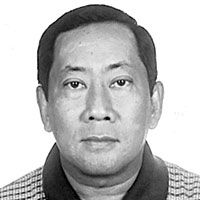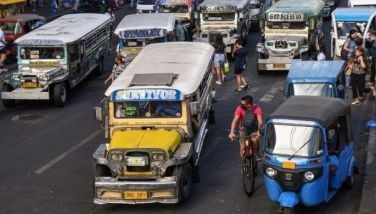60 years: Remembering the Liberation of Cebu

March 28, 2005 | 12:00am
Last Saturday, March 26, was the 60th anniversary of the Liberation of Cebu, a.k.a. the Talisay Landing. Unfortunately this year, this date fell on Black Saturday and since there were no newspapers in Cebu, this date would have passed into oblivion, hence we’re writing about this historic event today. I got the historical accounts on the Liberation of Cebu from the book Under the Southern Cross The Saga of the Americal Division, written by Capt. Francis D. Cron and printed by the Combat Forces Press.
The Americans came back to liberate Cebu at dawn of "E-Day" on March 26, 1945 when the 59 vessels (five destroyers, four assault personnel destroyers, eight minesweepers, 17 LSTs, 11 LSMs and 14 LCIs) of the Victor II attack group, covered by the 7th Fleet’s Task Force 74 with seven combat and 31 service units loomed before the sandy beaches of the town of Talisay. At exactly 7:30 in the morning, US naval guns fired on Talisay beach, with tons of shells supported by the rocket-firing LCIs. The bombardment lasted for a full hour. There were no reports of any Japanese batteries returning fire against the US naval invasion forces.
At 8:30 a.m., the first elements of the Americal Division on board their LVTs led by Gen. William H. Arnold waded to the shores of Talisay and Tangke. First ashore on "Green Beach 1, Green Beach 2 and Green Beach 3" were 5 LVTs (Landing Vehicle, Tracked) which were met by sporadic sniper and machine gun fire, the first-ever sign of Japanese resistance against the US invasion forces in Cebu.
The invasion by the Americal Division was almost a walk in the park if you compared the invasion of Cebu to the Leyte Landings or the invasion of Truk lagoon, until the first wave of the Americal Division hit a minefield, where 10 of the first 15 LVTs were disabled or destroyed by Japanese landmines. Later reports showed that the Japanese defenses in Talisay were the most elaborate and effective defense of any beachhead in the entire Philippine campaign. The Americans didn’t get this kind of reception from the Japanese in Tacloban City’s Red Beach.
With the minefields holding the first wave in check, the second wave came ashore and a minor traffic jam occurred. It took an hour and a half to clear the minefields with American landing equipment and materiel stuck from Talisay to Tangke. As fate would have it, the Japanese did not choose to fight vigorously on the beaches of Talisay and Tangke as they had other plans waiting for the American invaders. In hindsight, had the Japanese attacked the now stuck invading Americans, it certainly would have been a bloody battle.
As planned, once ashore, the Philippine Army’s 82d Division headed by Col. James Cushing was to be placed under the control of the Americal Division, their assignment was to capture the Buhisan Dam, just north of Cebu City. Later in the evening, Gen. Arnold transferred his headquarters from the USS Spencer to the shore in Talisay. Meanwhile, the 182d Infantry secured the railroad and bridge crossing the Managa River and after a brief firefight, where some 88 Japanese soldiers were killed and 10 were captured, they now held portions of the highway in Pardo, which is next to Talisay.
Before nightfall, the guerrillas of the Philippine 82d Division reported that they had secured their objective, which was the Buhisan Dam (today, this still serves as Cebu City’s only surface water reservoir), but subsequent reconnaissance patrols revealed that the Filipino guerrillas actually held the high ground overlooking the water installations, but hadn’t capture it.
All told, 60 years ago on March 26, 1945, close to a hundred Japanese were killed, while American casualties was placed at eight killed and 39 wounded, mostly due to the destruction wrought by the Japanese landmines on Talisay beach. It was a small price to pay to have Cebu finally liberated from the brutal Japanese occupiers. But that was only for E-Day. More action would be seen in Cebu in the following days and months to come.
On March 27, the Americal Division entered Cebu City, the valuable Port of Cebu, which made the Americans decide to abandon the beaches of Talisay, as the Cebu Port was still intact. Later, the Cebu Provincial Capitol fell into the hands of the Americans. But they found that most of Cebu City was destroyed by the Japanese before they took off for the mountains of Babag and Kang-Irag. Actually, the Americans themselves contributed greatly to the destruction of Cebu City, where US Navy warplanes strafed and bombed many ships anchored in the Port of Cebu.
As Capt. Cron, in his book Under the Southern Cross, wrote, "Before abandoning Cebu City on E-Day, the Japanese destroyed or damaged a number of buildings and homes which had previously been in good condition. Troops inspecting the capital city now found it a mass of rubble and ruin somewhat unmindful of the results of the fighting in the European Theater of Operations. The damage, however, had not all been wrought by the enemy."
When my uncle Col. Manuel F. Sequra wrote his first book, Tabunan, which is about the guerrilla operations in Cebu under the command of Col. James Cushing, he showed me photographs taken by US aviators flying American Consolidated B-24 Liberators carpet-bombing Cebu City into a heap of rubble. In short, the Japanese merely had to destroy what the American bombs had left untouched, which is why almost 90 percent of the entire City of Cebu became a pile of rubble.
The Teatro Oriente operated by my grandfather, Jose Avila, was razed to the ground, including his English language newspaper, the Cebu Advertiser, and he was left with nothing. So, too, with most Cebuano families with businesses on Colon street. By the end of the war, the business district of Cebu City was temporarily moved to T. Padilla street which became a mini-Colon street.
On March 28, most of Cebu City was under the Americal Division, except the mountains and hills nearby (now Beverly Hills) and the Lahug airfield. Go Chan Hill (now called Ecotech) was to be the first big bloody battle for Cebu City, where in two days of fighting, more than 200 Japanese soldiers were killed, 85 pillboxes neutralized and one Sherman Tank was disabled. This was the start of the bigger Battle of Babag, which was to take place a few weeks later, but I will feature that story sometime in the future.
For e-mail responses to this article, write to [email protected]. Bobit Avila’s columns can also be accessed through www.thefreeman.com. He also hosts a weekly talk show, "Straight from the Sky," shown every Monday, at 8 p.m., only in Metro Cebu on Channel 15 of SkyCable.
The Americans came back to liberate Cebu at dawn of "E-Day" on March 26, 1945 when the 59 vessels (five destroyers, four assault personnel destroyers, eight minesweepers, 17 LSTs, 11 LSMs and 14 LCIs) of the Victor II attack group, covered by the 7th Fleet’s Task Force 74 with seven combat and 31 service units loomed before the sandy beaches of the town of Talisay. At exactly 7:30 in the morning, US naval guns fired on Talisay beach, with tons of shells supported by the rocket-firing LCIs. The bombardment lasted for a full hour. There were no reports of any Japanese batteries returning fire against the US naval invasion forces.
At 8:30 a.m., the first elements of the Americal Division on board their LVTs led by Gen. William H. Arnold waded to the shores of Talisay and Tangke. First ashore on "Green Beach 1, Green Beach 2 and Green Beach 3" were 5 LVTs (Landing Vehicle, Tracked) which were met by sporadic sniper and machine gun fire, the first-ever sign of Japanese resistance against the US invasion forces in Cebu.
The invasion by the Americal Division was almost a walk in the park if you compared the invasion of Cebu to the Leyte Landings or the invasion of Truk lagoon, until the first wave of the Americal Division hit a minefield, where 10 of the first 15 LVTs were disabled or destroyed by Japanese landmines. Later reports showed that the Japanese defenses in Talisay were the most elaborate and effective defense of any beachhead in the entire Philippine campaign. The Americans didn’t get this kind of reception from the Japanese in Tacloban City’s Red Beach.
With the minefields holding the first wave in check, the second wave came ashore and a minor traffic jam occurred. It took an hour and a half to clear the minefields with American landing equipment and materiel stuck from Talisay to Tangke. As fate would have it, the Japanese did not choose to fight vigorously on the beaches of Talisay and Tangke as they had other plans waiting for the American invaders. In hindsight, had the Japanese attacked the now stuck invading Americans, it certainly would have been a bloody battle.
As planned, once ashore, the Philippine Army’s 82d Division headed by Col. James Cushing was to be placed under the control of the Americal Division, their assignment was to capture the Buhisan Dam, just north of Cebu City. Later in the evening, Gen. Arnold transferred his headquarters from the USS Spencer to the shore in Talisay. Meanwhile, the 182d Infantry secured the railroad and bridge crossing the Managa River and after a brief firefight, where some 88 Japanese soldiers were killed and 10 were captured, they now held portions of the highway in Pardo, which is next to Talisay.
Before nightfall, the guerrillas of the Philippine 82d Division reported that they had secured their objective, which was the Buhisan Dam (today, this still serves as Cebu City’s only surface water reservoir), but subsequent reconnaissance patrols revealed that the Filipino guerrillas actually held the high ground overlooking the water installations, but hadn’t capture it.
All told, 60 years ago on March 26, 1945, close to a hundred Japanese were killed, while American casualties was placed at eight killed and 39 wounded, mostly due to the destruction wrought by the Japanese landmines on Talisay beach. It was a small price to pay to have Cebu finally liberated from the brutal Japanese occupiers. But that was only for E-Day. More action would be seen in Cebu in the following days and months to come.
On March 27, the Americal Division entered Cebu City, the valuable Port of Cebu, which made the Americans decide to abandon the beaches of Talisay, as the Cebu Port was still intact. Later, the Cebu Provincial Capitol fell into the hands of the Americans. But they found that most of Cebu City was destroyed by the Japanese before they took off for the mountains of Babag and Kang-Irag. Actually, the Americans themselves contributed greatly to the destruction of Cebu City, where US Navy warplanes strafed and bombed many ships anchored in the Port of Cebu.
As Capt. Cron, in his book Under the Southern Cross, wrote, "Before abandoning Cebu City on E-Day, the Japanese destroyed or damaged a number of buildings and homes which had previously been in good condition. Troops inspecting the capital city now found it a mass of rubble and ruin somewhat unmindful of the results of the fighting in the European Theater of Operations. The damage, however, had not all been wrought by the enemy."
When my uncle Col. Manuel F. Sequra wrote his first book, Tabunan, which is about the guerrilla operations in Cebu under the command of Col. James Cushing, he showed me photographs taken by US aviators flying American Consolidated B-24 Liberators carpet-bombing Cebu City into a heap of rubble. In short, the Japanese merely had to destroy what the American bombs had left untouched, which is why almost 90 percent of the entire City of Cebu became a pile of rubble.
The Teatro Oriente operated by my grandfather, Jose Avila, was razed to the ground, including his English language newspaper, the Cebu Advertiser, and he was left with nothing. So, too, with most Cebuano families with businesses on Colon street. By the end of the war, the business district of Cebu City was temporarily moved to T. Padilla street which became a mini-Colon street.
On March 28, most of Cebu City was under the Americal Division, except the mountains and hills nearby (now Beverly Hills) and the Lahug airfield. Go Chan Hill (now called Ecotech) was to be the first big bloody battle for Cebu City, where in two days of fighting, more than 200 Japanese soldiers were killed, 85 pillboxes neutralized and one Sherman Tank was disabled. This was the start of the bigger Battle of Babag, which was to take place a few weeks later, but I will feature that story sometime in the future.
BrandSpace Articles
<
>
- Latest
- Trending
Trending
Latest
Trending
Latest
Recommended






























